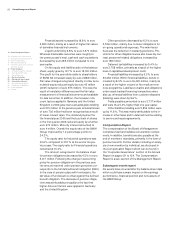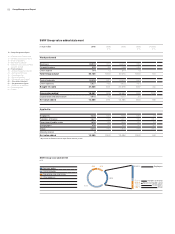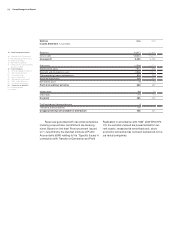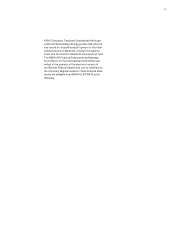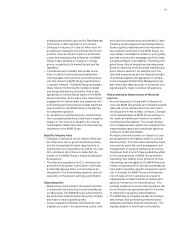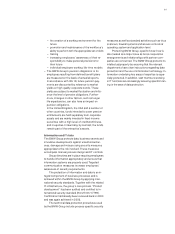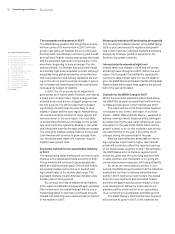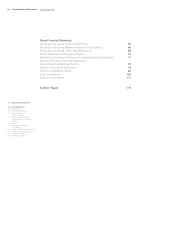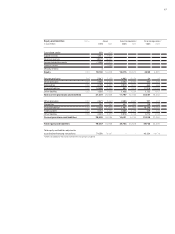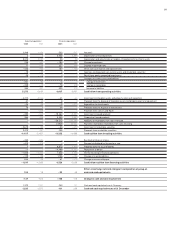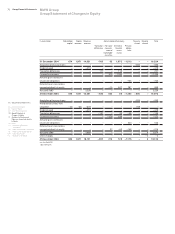BMW 2006 Annual Report Download - page 61
Download and view the complete annual report
Please find page 61 of the 2006 BMW annual report below. You can navigate through the pages in the report by either clicking on the pages listed below, or by using the keyword search tool below to find specific information within the annual report.60 Group Management Report
10 Group Management Report
10 A Review of the Financial Year
12
General EconomicEnvironment
15 Review of operations
38 BMW Stock and Bonds
41 Disclosures pursuant to §289 (4)
and §315 (4) HGB
43 Financial Analysis
43 – Internal Management System
44 – Earnings performance
46 – Financial position
48 – Net assets position
50 – Subsequent events report
50 – Value added statement
53 – Key performance figures
54 – Comments on BMW AG
58 Risk Management
62 Outlook
means of a rolling cash flow forecast. As part of a
value-based interest rate management system,
interest rate risks are measured and limited using
a value-at-risk approach. The risk-return ratio is
tested continuously using simulated computations.
In addition, sensitivity analyses are prepared
to measure the potential impact of interest rate
changes on earnings.
– In order to avoid currency risks, financing and lease
business is refinanced, as a general rule, in the
currency of the relevant market.
– A major part of financing and lease business with-
in the Financial Services segment is refinanced
on the capital markets. As a result of its good
credit standing, reflected in the long-standing
first-class short-term ratings issued by Moody’s
(P-1) and Standard& Poor’s (A-1), the BMW Group
is able to obtain competitive conditions.The long-
term ratings for the BMW Group published by
Standard& Poor’s and Moody’s in September2005
remain valid, enabling the BMW Group to obtain
competitive conditions. Moody’s issued an A1
rating and Standard&Poor’s an A+ rating, both
with stable outlook.
– Various methods and systems such as credit-
rating and scoring are in place to manage credit
risk, partly in the light of Basle II requirements.
Depending on the credit volume applied for and
the credit risk rating of the party involved, financing
applications for international dealers, importers
and fleet customers are presented to the local,
regional or corporate credit committees for
ap-
proval. A two-step credit application process helps
to reduce the risk of default affecting the Group’s
worldwide financial services operations.This
process, which is based on clear and binding
credit risk rules applicable throughout the group,
also specifies the maximum amounts of un-
secured
credit volumes permitted (“unsecured
risks”). The dual control principle applies world-
wide and is rigorously implemented. In another
measure to reduce risk, the BMW Group is con-
tinuously making efforts to standardise its credit-
decision processes and the quality of those
processes on a worldwide basis, and to ensure
that uniform rating systems are in place. Close
contact to borrowers, a thorough knowledge of
the vehicle products sold, local credit checks and
on-going measurement of collateral all make a
vital contribution towards avoiding losses, particu-
larly in the case of lower rating categories. On top
of this, the dynamic global credit markets will con-
tinue to supply highly flexible instruments to miti-
gate risk (e.g. securitisation, coverage using credit
derivatives, credit syndication).
For retail customer financing purposes, the BMW
Group uses validated scorecards in order to reach
credit decisions more quickly and to monitor risk.
Criteria such as arrears and bad debt ratios are
analysed monthly and used to actively manage
the credit portfolio and to improve portfolio quality.
Legal risks
– The BMW Group is not involved in any court or
arbitration proceedings which could have a sig-
nificant
impact on the economic position of the
Group.
– Like all enterprises, the BMW Group is exposed
to the risk of warranty claims. Adequate provisions
have been recognised in the balance sheet to
cover such claims. Part of the risk, especially where
the American market is concerned, has been in-
sured externally up to economically acceptable
levels. The high quality of BMW Group products,
additionally ensured by regular quality audits and
on-going improvement measures, helps to reduce
this risk. In comparison with competitors, this
can give rise to benefits and opportunities for the
BMW Group.
–
Changes in the regulatory environment may im-
pair the sales volume, revenues and earnings
performance of the BMW Group in individual mar-
kets or economic regions.
Personnel risks
– As an attractive employer, the BMW Group has
found itself in a favourable position for many years
in the intense competition for qualified technical
and managerial staff. Employee satisfaction and
a low level of employee fluctuation also help to
minimise the risk of know-how drift.
– An ageing and shrinking population in Germany
will have a lasting impact on the conditions pre-
vailing in the labour, product, services and financial
markets. Demographic changes will give rise to
risks and opportunities which enterprises will
be
increasingly faced with in coming years.The
BMW Group carefully reviews the effects of
demographic change on operations, focusing in
particular on the following issues:


